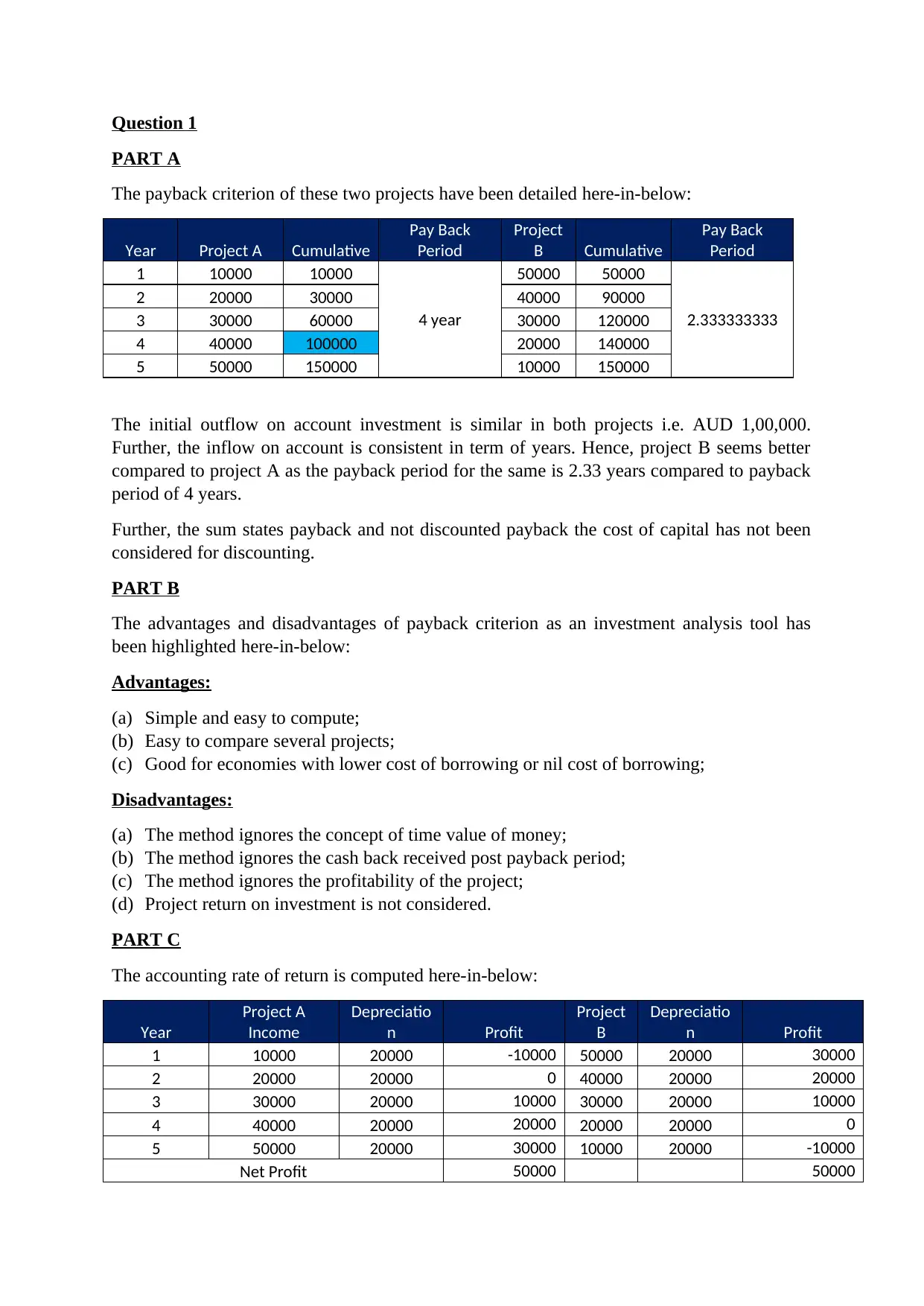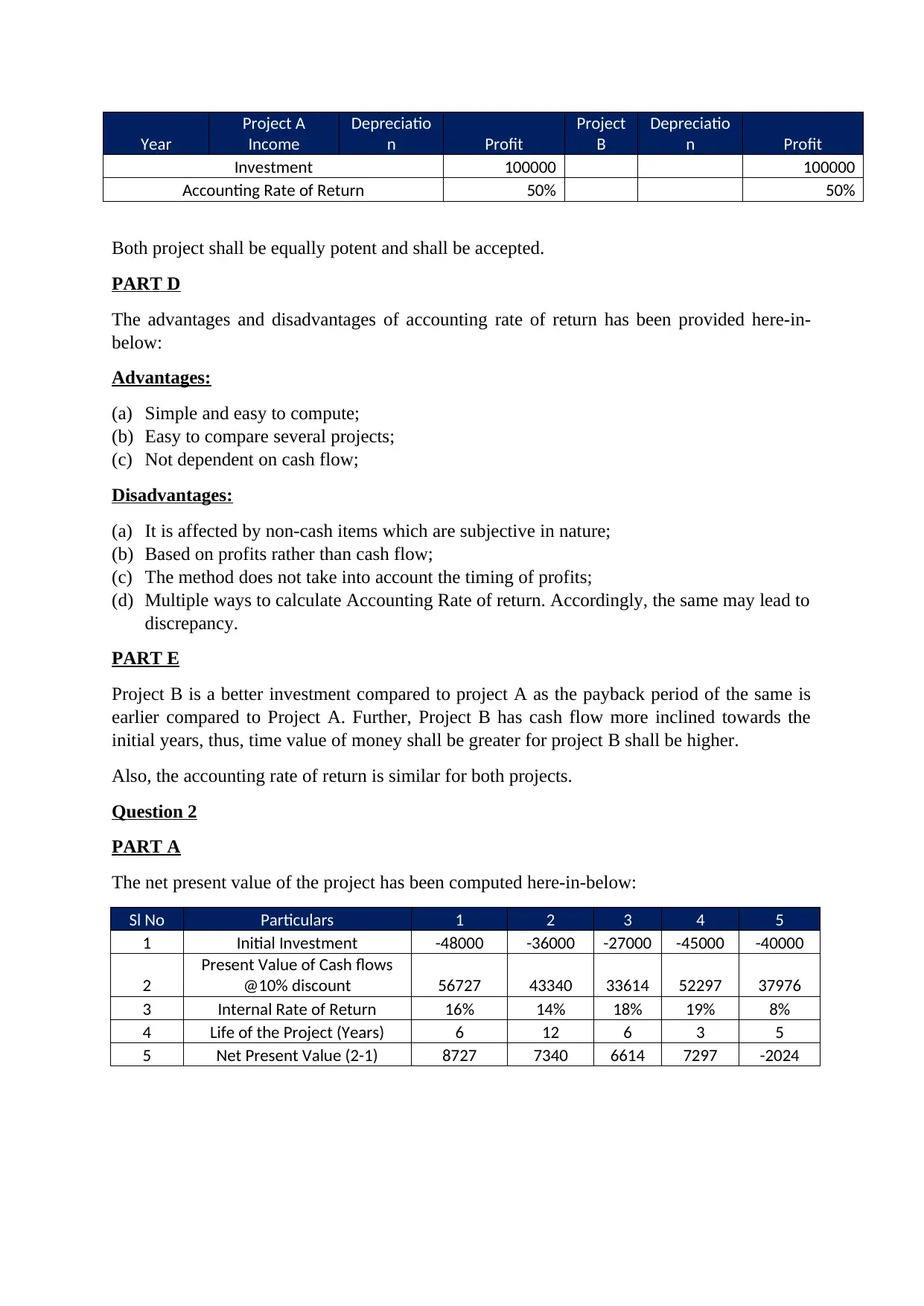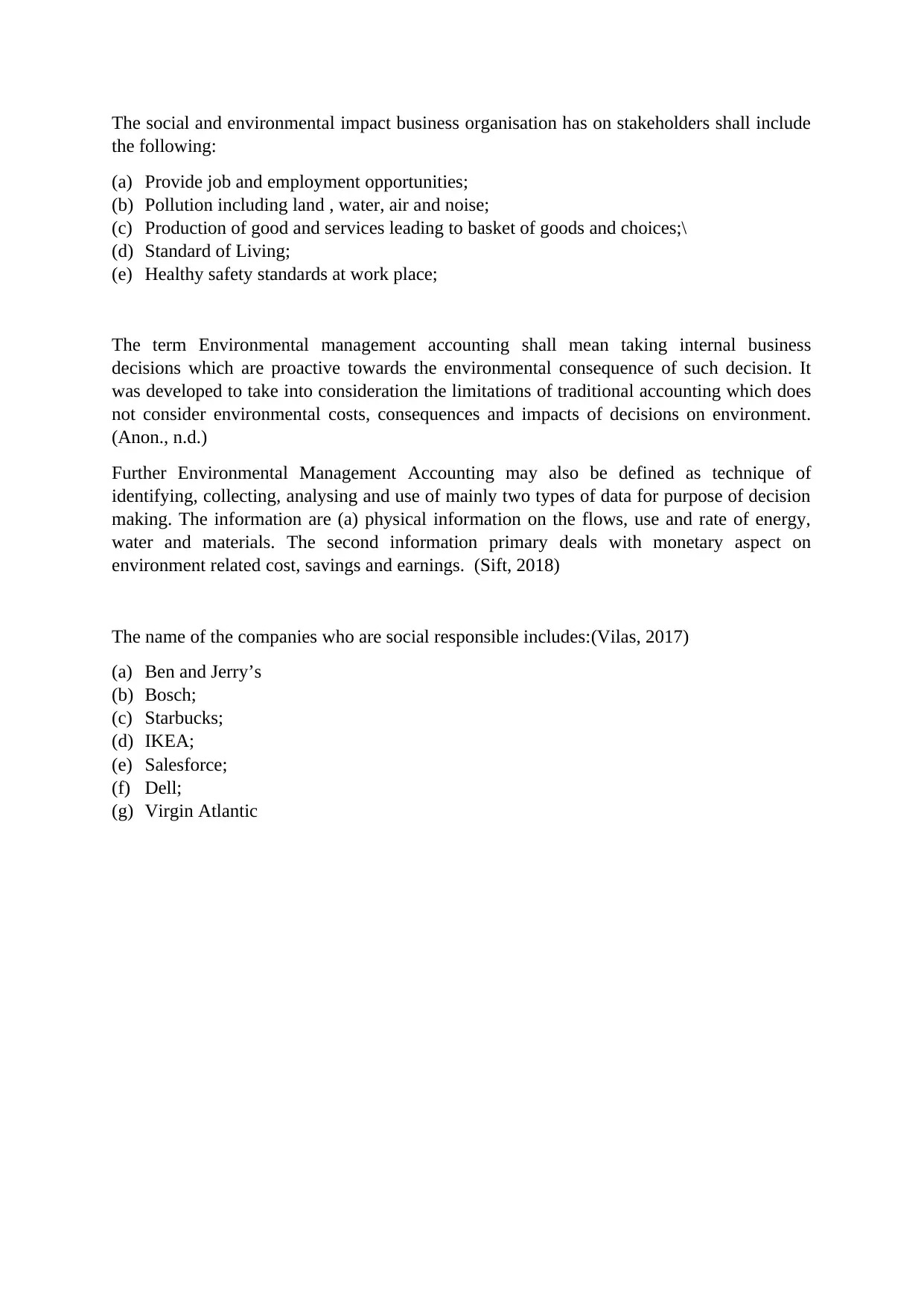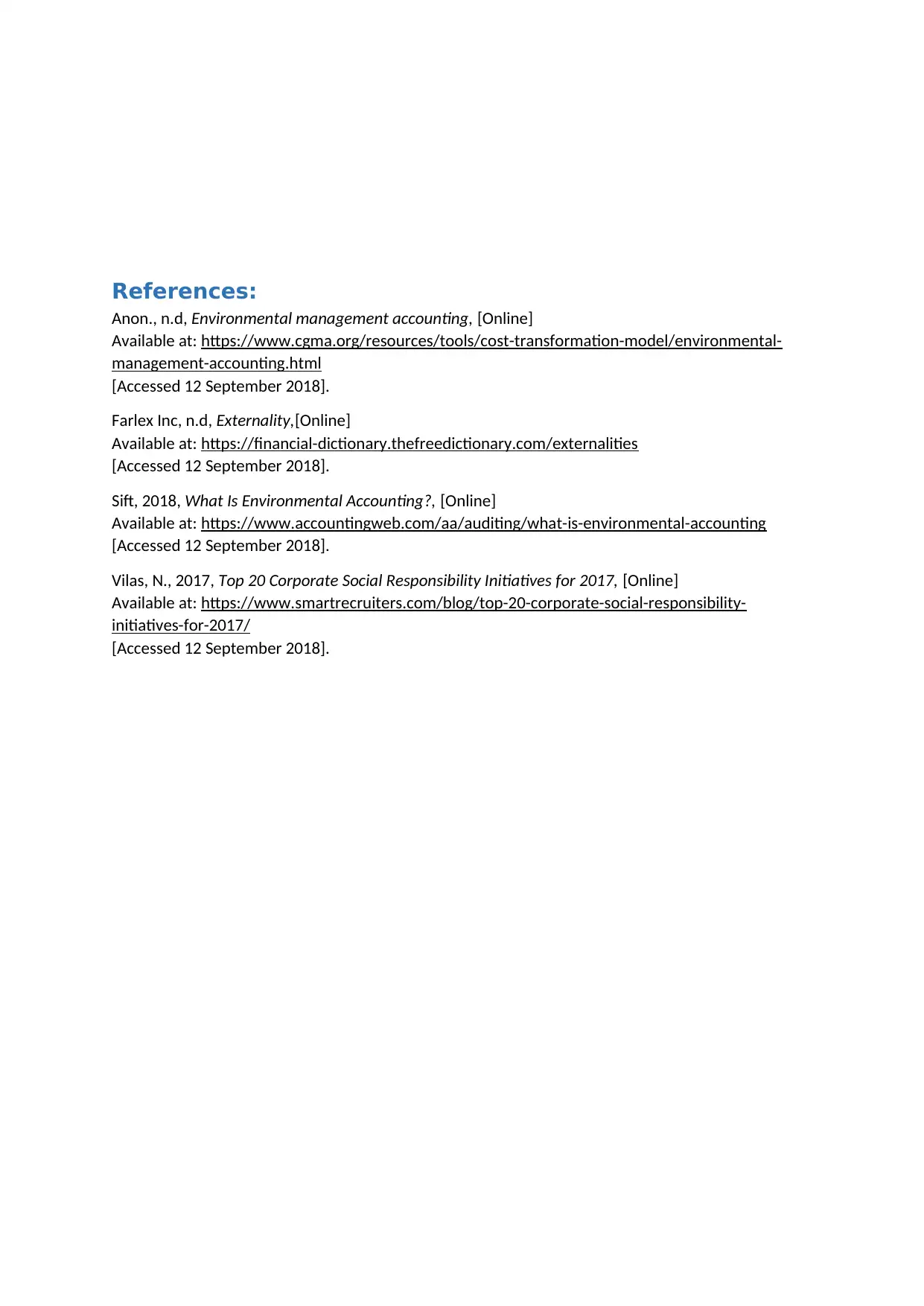Analyzing Investment Projects: A Financial Perspective - [University]
VerifiedAdded on 2023/06/06
|6
|1794
|221
Project
AI Summary
This project comprehensively analyzes investment decisions using various financial metrics. It begins with a payback period analysis of two projects, comparing their payback periods and discussing the advantages and disadvantages of this method. The project then computes the accounting rate of return (ARR) for the projects, evaluating their profitability and highlighting the pros and cons of ARR. Moving on to more advanced techniques, the assignment calculates the net present value (NPV) and profitability index for several projects, determining which projects are acceptable based on these metrics. A ranking of projects based on NPV, internal rate of return (IRR), and profitability index is also provided. The project also addresses the implications of inaccurate cash flow predictions and suggests strategies for mitigating losses and making informed investment decisions, including the advantages and disadvantages of discounted cash flow (DCF) analysis. Finally, the project explores the concept of externalities in financial transactions, their impact on stakeholders, and the role of environmental management accounting, along with examples of socially responsible companies.

Question 1
PART A
The payback criterion of these two projects have been detailed here-in-below:
Year Project A Cumulative
Pay Back
Period
Project
B Cumulative
Pay Back
Period
1 10000 10000
4 year
50000 50000
2.333333333
2 20000 30000 40000 90000
3 30000 60000 30000 120000
4 40000 100000 20000 140000
5 50000 150000 10000 150000
The initial outflow on account investment is similar in both projects i.e. AUD 1,00,000.
Further, the inflow on account is consistent in term of years. Hence, project B seems better
compared to project A as the payback period for the same is 2.33 years compared to payback
period of 4 years.
Further, the sum states payback and not discounted payback the cost of capital has not been
considered for discounting.
PART B
The advantages and disadvantages of payback criterion as an investment analysis tool has
been highlighted here-in-below:
Advantages:
(a) Simple and easy to compute;
(b) Easy to compare several projects;
(c) Good for economies with lower cost of borrowing or nil cost of borrowing;
Disadvantages:
(a) The method ignores the concept of time value of money;
(b) The method ignores the cash back received post payback period;
(c) The method ignores the profitability of the project;
(d) Project return on investment is not considered.
PART C
The accounting rate of return is computed here-in-below:
Year
Project A
Income
Depreciatio
n Profit
Project
B
Depreciatio
n Profit
1 10000 20000 -10000 50000 20000 30000
2 20000 20000 0 40000 20000 20000
3 30000 20000 10000 30000 20000 10000
4 40000 20000 20000 20000 20000 0
5 50000 20000 30000 10000 20000 -10000
Net Profit 50000 50000
PART A
The payback criterion of these two projects have been detailed here-in-below:
Year Project A Cumulative
Pay Back
Period
Project
B Cumulative
Pay Back
Period
1 10000 10000
4 year
50000 50000
2.333333333
2 20000 30000 40000 90000
3 30000 60000 30000 120000
4 40000 100000 20000 140000
5 50000 150000 10000 150000
The initial outflow on account investment is similar in both projects i.e. AUD 1,00,000.
Further, the inflow on account is consistent in term of years. Hence, project B seems better
compared to project A as the payback period for the same is 2.33 years compared to payback
period of 4 years.
Further, the sum states payback and not discounted payback the cost of capital has not been
considered for discounting.
PART B
The advantages and disadvantages of payback criterion as an investment analysis tool has
been highlighted here-in-below:
Advantages:
(a) Simple and easy to compute;
(b) Easy to compare several projects;
(c) Good for economies with lower cost of borrowing or nil cost of borrowing;
Disadvantages:
(a) The method ignores the concept of time value of money;
(b) The method ignores the cash back received post payback period;
(c) The method ignores the profitability of the project;
(d) Project return on investment is not considered.
PART C
The accounting rate of return is computed here-in-below:
Year
Project A
Income
Depreciatio
n Profit
Project
B
Depreciatio
n Profit
1 10000 20000 -10000 50000 20000 30000
2 20000 20000 0 40000 20000 20000
3 30000 20000 10000 30000 20000 10000
4 40000 20000 20000 20000 20000 0
5 50000 20000 30000 10000 20000 -10000
Net Profit 50000 50000
Paraphrase This Document
Need a fresh take? Get an instant paraphrase of this document with our AI Paraphraser

Year
Project A
Income
Depreciatio
n Profit
Project
B
Depreciatio
n Profit
Investment 100000 100000
Accounting Rate of Return 50% 50%
Both project shall be equally potent and shall be accepted.
PART D
The advantages and disadvantages of accounting rate of return has been provided here-in-
below:
Advantages:
(a) Simple and easy to compute;
(b) Easy to compare several projects;
(c) Not dependent on cash flow;
Disadvantages:
(a) It is affected by non-cash items which are subjective in nature;
(b) Based on profits rather than cash flow;
(c) The method does not take into account the timing of profits;
(d) Multiple ways to calculate Accounting Rate of return. Accordingly, the same may lead to
discrepancy.
PART E
Project B is a better investment compared to project A as the payback period of the same is
earlier compared to Project A. Further, Project B has cash flow more inclined towards the
initial years, thus, time value of money shall be greater for project B shall be higher.
Also, the accounting rate of return is similar for both projects.
Question 2
PART A
The net present value of the project has been computed here-in-below:
Sl No Particulars 1 2 3 4 5
1 Initial Investment -48000 -36000 -27000 -45000 -40000
2
Present Value of Cash flows
@10% discount 56727 43340 33614 52297 37976
3 Internal Rate of Return 16% 14% 18% 19% 8%
4 Life of the Project (Years) 6 12 6 3 5
5 Net Present Value (2-1) 8727 7340 6614 7297 -2024
Project A
Income
Depreciatio
n Profit
Project
B
Depreciatio
n Profit
Investment 100000 100000
Accounting Rate of Return 50% 50%
Both project shall be equally potent and shall be accepted.
PART D
The advantages and disadvantages of accounting rate of return has been provided here-in-
below:
Advantages:
(a) Simple and easy to compute;
(b) Easy to compare several projects;
(c) Not dependent on cash flow;
Disadvantages:
(a) It is affected by non-cash items which are subjective in nature;
(b) Based on profits rather than cash flow;
(c) The method does not take into account the timing of profits;
(d) Multiple ways to calculate Accounting Rate of return. Accordingly, the same may lead to
discrepancy.
PART E
Project B is a better investment compared to project A as the payback period of the same is
earlier compared to Project A. Further, Project B has cash flow more inclined towards the
initial years, thus, time value of money shall be greater for project B shall be higher.
Also, the accounting rate of return is similar for both projects.
Question 2
PART A
The net present value of the project has been computed here-in-below:
Sl No Particulars 1 2 3 4 5
1 Initial Investment -48000 -36000 -27000 -45000 -40000
2
Present Value of Cash flows
@10% discount 56727 43340 33614 52297 37976
3 Internal Rate of Return 16% 14% 18% 19% 8%
4 Life of the Project (Years) 6 12 6 3 5
5 Net Present Value (2-1) 8727 7340 6614 7297 -2024

PART B
The Profitability index has been computed here-in-below:
Sl No Particulars 1 2 3 4 5
1 Initial Investment -48000 -36000 -27000 -45000 -40000
2
Present Value of Cash flows
@10% discount 56727 43340 33614 52297 37976
3 Internal Rate of Return 16% 14% 18% 19% 8%
4 Life of the Project (Years) 6 12 6 3 5
5 Net Present Value (2-1) 8727 7340 6614 7297 -2024
6 Profitability Index (2/1) 1.18 1.20 1.24 1.16 0.95
PART C
The projects that should be acceptable to Emrico is 1,2,3 and 4 as the net present value of the
project is positive and profitability index is greater than 1.
PART D
The ranking has been done here-in-below
Sl No Particulars 1 2 3 4 5
1 Initial Investment -48000 -36000 -27000 -45000 -40000
2
Present Value of Cash flows
@10% discount 56727 43340 33614 52297 37976
3 Internal Rate of Return 16% 14% 18% 19% 8%
4 Life of the Project (Years) 6 12 6 3 5
5 Net Present Value (2-1) 8727 7340 6614 7297 -2024
6 Profitability Index (2/1) 1.18 1.20 1.24 1.16 0.95
7
Ranking on the basis of Net
Present value 1 2 4 3 5
8
Ranking on the basis of
Internal Rate of Return 3 4 2 1 5
9
Ranking on the basis of
Profitability Index 3 2 1 4 5
PART E
On the basis of above table project 3 has the highest profitability index while project 4 has
the highest internal rate of return and project 1 has the highest net present value. According,
to me the company should go for the 1st project as it has the highest NPV which is the chief
factor while analysing the investment. The higher inflow of capital shall help company to
invest more in future.
The Profitability index has been computed here-in-below:
Sl No Particulars 1 2 3 4 5
1 Initial Investment -48000 -36000 -27000 -45000 -40000
2
Present Value of Cash flows
@10% discount 56727 43340 33614 52297 37976
3 Internal Rate of Return 16% 14% 18% 19% 8%
4 Life of the Project (Years) 6 12 6 3 5
5 Net Present Value (2-1) 8727 7340 6614 7297 -2024
6 Profitability Index (2/1) 1.18 1.20 1.24 1.16 0.95
PART C
The projects that should be acceptable to Emrico is 1,2,3 and 4 as the net present value of the
project is positive and profitability index is greater than 1.
PART D
The ranking has been done here-in-below
Sl No Particulars 1 2 3 4 5
1 Initial Investment -48000 -36000 -27000 -45000 -40000
2
Present Value of Cash flows
@10% discount 56727 43340 33614 52297 37976
3 Internal Rate of Return 16% 14% 18% 19% 8%
4 Life of the Project (Years) 6 12 6 3 5
5 Net Present Value (2-1) 8727 7340 6614 7297 -2024
6 Profitability Index (2/1) 1.18 1.20 1.24 1.16 0.95
7
Ranking on the basis of Net
Present value 1 2 4 3 5
8
Ranking on the basis of
Internal Rate of Return 3 4 2 1 5
9
Ranking on the basis of
Profitability Index 3 2 1 4 5
PART E
On the basis of above table project 3 has the highest profitability index while project 4 has
the highest internal rate of return and project 1 has the highest net present value. According,
to me the company should go for the 1st project as it has the highest NPV which is the chief
factor while analysing the investment. The higher inflow of capital shall help company to
invest more in future.
⊘ This is a preview!⊘
Do you want full access?
Subscribe today to unlock all pages.

Trusted by 1+ million students worldwide

Question 3
In the present circumstance, the prediction and estimation made regarding the cash flows of
the project did not hold good. Accordingly, the rate of return of the project fell below the cost
of capital and created issues in the company. Since discounting cash flows is based on
estimation of future which is unpredictable, the same may lead to unreliable solutions if
appropriate assumptions are not undertaken while predicting cash flow.
Under such a scenario reliable estimation needs to be undertaken of the proposed scenario
with a probabilistic tool to account for good, medium and worst scenario. Since the project
has fallen into dark, one needs to analyse right now whether the cash flows in the future can
exceed the cost of capital or they shall remain below the level here-in-after. Thus, a proper
accounting of cash flows while taking different factors and situation need to be undertaken.
Second thing, the management may look for appropriate exit tool in order to minimise the
loss if they cannot see reliable return.
Thirdly, one needs to analyse the return earned under the current scenario and the stand of the
management that in case such investment has not been made more loss have occurred
symbolising lack of alternatives or opportunity in the market. Thus, one need to look at if
other project has a return lower than the current one. If, the answer to the same is yes then it
shall continue with investment.
The advantages and disadvantages of DCF are described here-in-below;
Advantages
(a) It provides a close estimate of intrinsic value of stock;
(b) It removes discrepancy involved in accounting principles;
(c) It is not influenced by short term market factors or non-economic factors;
(d) It is most useful when there is high degree probability of cashinflows.
Disadvantages
(a) Involves too much assumption;
(b) Prediction of future is not easy;
(c) Sensitivity level is high;
(d) It is a time intensive process compared to other method.
Question 4
In terms of Financial Dictionary, externalities mean the cost and profit of a particular activity
or transaction to others who are not associated with such transaction. Further, the same can be
positive or negative. Let us take an example to understand the same in detail. Suppose a
merger of two enterprise take place which eventually shall lead to higher prices, bonus for
employees. Thus it can benefit both shareholders and employees of the company. However,
the same may lead to elimination of one competitor from market, there can be job layoff
impacting society.(Farlex Inc, n.d.) Thus in layman it is spill over effect or neighbouring
effect.
In the present circumstance, the prediction and estimation made regarding the cash flows of
the project did not hold good. Accordingly, the rate of return of the project fell below the cost
of capital and created issues in the company. Since discounting cash flows is based on
estimation of future which is unpredictable, the same may lead to unreliable solutions if
appropriate assumptions are not undertaken while predicting cash flow.
Under such a scenario reliable estimation needs to be undertaken of the proposed scenario
with a probabilistic tool to account for good, medium and worst scenario. Since the project
has fallen into dark, one needs to analyse right now whether the cash flows in the future can
exceed the cost of capital or they shall remain below the level here-in-after. Thus, a proper
accounting of cash flows while taking different factors and situation need to be undertaken.
Second thing, the management may look for appropriate exit tool in order to minimise the
loss if they cannot see reliable return.
Thirdly, one needs to analyse the return earned under the current scenario and the stand of the
management that in case such investment has not been made more loss have occurred
symbolising lack of alternatives or opportunity in the market. Thus, one need to look at if
other project has a return lower than the current one. If, the answer to the same is yes then it
shall continue with investment.
The advantages and disadvantages of DCF are described here-in-below;
Advantages
(a) It provides a close estimate of intrinsic value of stock;
(b) It removes discrepancy involved in accounting principles;
(c) It is not influenced by short term market factors or non-economic factors;
(d) It is most useful when there is high degree probability of cashinflows.
Disadvantages
(a) Involves too much assumption;
(b) Prediction of future is not easy;
(c) Sensitivity level is high;
(d) It is a time intensive process compared to other method.
Question 4
In terms of Financial Dictionary, externalities mean the cost and profit of a particular activity
or transaction to others who are not associated with such transaction. Further, the same can be
positive or negative. Let us take an example to understand the same in detail. Suppose a
merger of two enterprise take place which eventually shall lead to higher prices, bonus for
employees. Thus it can benefit both shareholders and employees of the company. However,
the same may lead to elimination of one competitor from market, there can be job layoff
impacting society.(Farlex Inc, n.d.) Thus in layman it is spill over effect or neighbouring
effect.
Paraphrase This Document
Need a fresh take? Get an instant paraphrase of this document with our AI Paraphraser

The social and environmental impact business organisation has on stakeholders shall include
the following:
(a) Provide job and employment opportunities;
(b) Pollution including land , water, air and noise;
(c) Production of good and services leading to basket of goods and choices;\
(d) Standard of Living;
(e) Healthy safety standards at work place;
The term Environmental management accounting shall mean taking internal business
decisions which are proactive towards the environmental consequence of such decision. It
was developed to take into consideration the limitations of traditional accounting which does
not consider environmental costs, consequences and impacts of decisions on environment.
(Anon., n.d.)
Further Environmental Management Accounting may also be defined as technique of
identifying, collecting, analysing and use of mainly two types of data for purpose of decision
making. The information are (a) physical information on the flows, use and rate of energy,
water and materials. The second information primary deals with monetary aspect on
environment related cost, savings and earnings. (Sift, 2018)
The name of the companies who are social responsible includes:(Vilas, 2017)
(a) Ben and Jerry’s
(b) Bosch;
(c) Starbucks;
(d) IKEA;
(e) Salesforce;
(f) Dell;
(g) Virgin Atlantic
the following:
(a) Provide job and employment opportunities;
(b) Pollution including land , water, air and noise;
(c) Production of good and services leading to basket of goods and choices;\
(d) Standard of Living;
(e) Healthy safety standards at work place;
The term Environmental management accounting shall mean taking internal business
decisions which are proactive towards the environmental consequence of such decision. It
was developed to take into consideration the limitations of traditional accounting which does
not consider environmental costs, consequences and impacts of decisions on environment.
(Anon., n.d.)
Further Environmental Management Accounting may also be defined as technique of
identifying, collecting, analysing and use of mainly two types of data for purpose of decision
making. The information are (a) physical information on the flows, use and rate of energy,
water and materials. The second information primary deals with monetary aspect on
environment related cost, savings and earnings. (Sift, 2018)
The name of the companies who are social responsible includes:(Vilas, 2017)
(a) Ben and Jerry’s
(b) Bosch;
(c) Starbucks;
(d) IKEA;
(e) Salesforce;
(f) Dell;
(g) Virgin Atlantic

References:
Anon., n.d, Environmental management accounting, [Online]
Available at: https://www.cgma.org/resources/tools/cost-transformation-model/environmental-
management-accounting.html
[Accessed 12 September 2018].
Farlex Inc, n.d, Externality,[Online]
Available at: https://financial-dictionary.thefreedictionary.com/externalities
[Accessed 12 September 2018].
Sift, 2018, What Is Environmental Accounting?, [Online]
Available at: https://www.accountingweb.com/aa/auditing/what-is-environmental-accounting
[Accessed 12 September 2018].
Vilas, N., 2017, Top 20 Corporate Social Responsibility Initiatives for 2017, [Online]
Available at: https://www.smartrecruiters.com/blog/top-20-corporate-social-responsibility-
initiatives-for-2017/
[Accessed 12 September 2018].
Anon., n.d, Environmental management accounting, [Online]
Available at: https://www.cgma.org/resources/tools/cost-transformation-model/environmental-
management-accounting.html
[Accessed 12 September 2018].
Farlex Inc, n.d, Externality,[Online]
Available at: https://financial-dictionary.thefreedictionary.com/externalities
[Accessed 12 September 2018].
Sift, 2018, What Is Environmental Accounting?, [Online]
Available at: https://www.accountingweb.com/aa/auditing/what-is-environmental-accounting
[Accessed 12 September 2018].
Vilas, N., 2017, Top 20 Corporate Social Responsibility Initiatives for 2017, [Online]
Available at: https://www.smartrecruiters.com/blog/top-20-corporate-social-responsibility-
initiatives-for-2017/
[Accessed 12 September 2018].
⊘ This is a preview!⊘
Do you want full access?
Subscribe today to unlock all pages.

Trusted by 1+ million students worldwide
1 out of 6
Related Documents
Your All-in-One AI-Powered Toolkit for Academic Success.
+13062052269
info@desklib.com
Available 24*7 on WhatsApp / Email
![[object Object]](/_next/static/media/star-bottom.7253800d.svg)
Unlock your academic potential
Copyright © 2020–2025 A2Z Services. All Rights Reserved. Developed and managed by ZUCOL.





